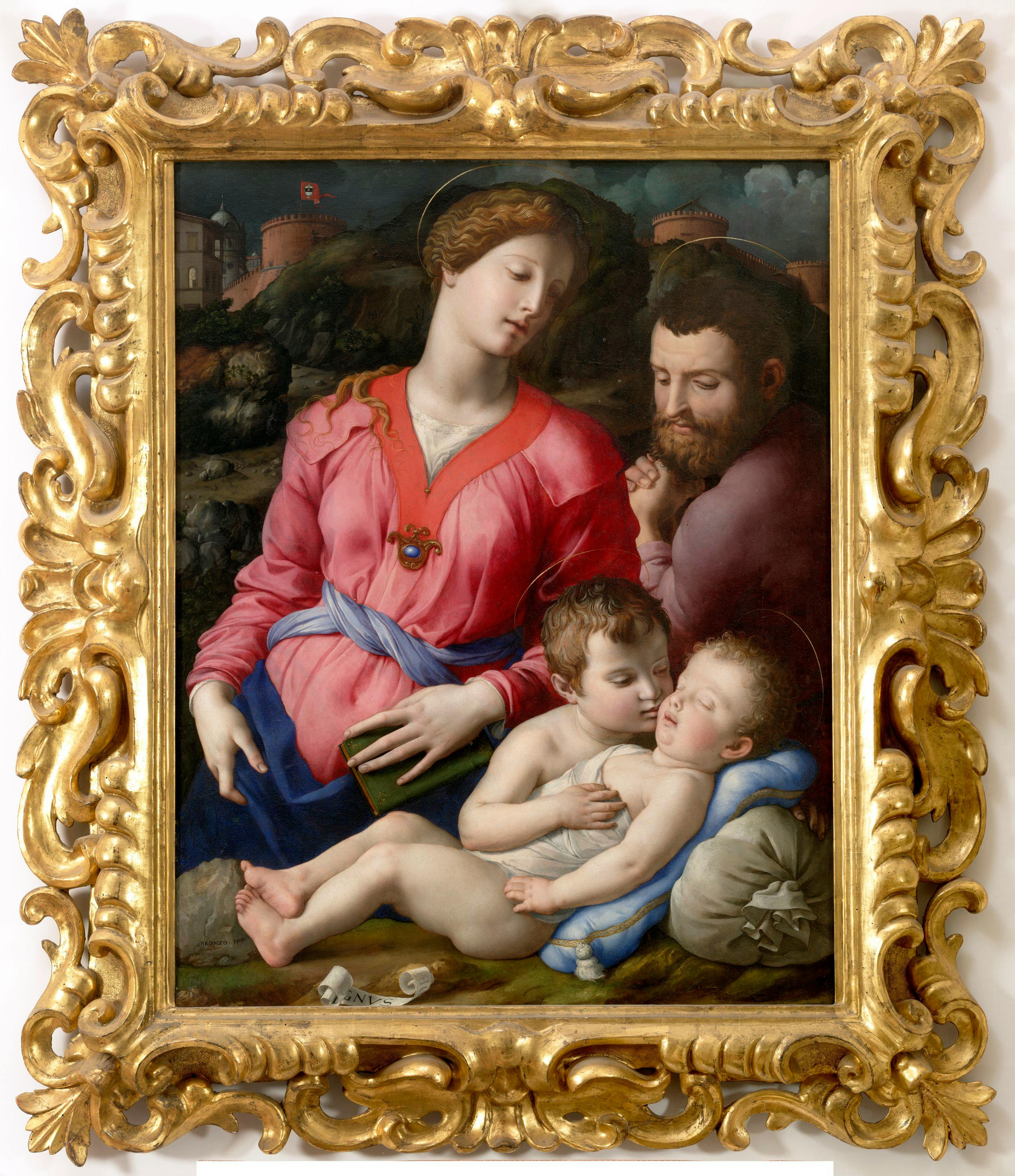Holy Family with young Saint John (Madonna Panciatichi)
Agnolo Tori known as Bronzino (Florence 1503- 1572)
In a suspended atmosphere, as if outside of time, Mary and Joseph keep watch over the sleeping Jesus, lying on a pillow to soften the hardness of the travel sack and cuddled by St. John who gently reaches out to touch his cheek. The little boy's gesture is not restricted to that family moment, but also becomes a premonition of the destiny of martyrdom that awaits both of them, John at the hands of Herod and Jesus on the cross. This is why the cloth that wraps the Child's body is a figure of the shroud, and the stone he points his feet against is a symbol of his tomb. The iconography of the scene intertwines the theme of the Holy Family and that of the Flight into Egypt, which medieval and Renaissance sources, with the intention of enriching the bare Gospel account, identify as one of the very first occasions Jesus and Saint John met. Behind them, the landscape of rocks slowly slopes down, bordering the view of a city with its walls and towers, domes and palaces. On the left keep there is a banner with the black and silver split coat of arms with a crossed ball in the upper part, the coat of arms of Bartolomeo Panciatichi, descendant of a family of ancient tradition, merchant, scholar and very faithful official of Cosimo de' Medici. Bartolomeo was one of Bronzino's most passionate patrons who, according to Vasari, painted at least five paintings for him which have now all been identified: in addition to this one, there are portraits of in the collections of the Uffizi Galleries (Inv. 1890, no. 741) and his wife Lucrezia (Inv. 1890 n. 736), the Holy Family now in Vienna (Inv. GG_183, Kunsthistorisches Museum), the crucified Christ now at the Musée des Beaux-Arts in Nice (Inv. N.Mba 196)
The Holy Family with young St. John the Baptist is one of Agnolo's most sophisticated creations, where one can observe the maturation of the characters that would become not only his trademark but also a reference model for the Florentine artistic generation of the following decades. Though in the preliminary setting of the scene there are countless homages to Michelangelo and the Tondo Doni (Inv. 1890 no. 1456), though in the monumental complexity of the Virgin and in the geometric volume of the head adorned with the thick wavy hairstyle one can see the in-depth study and highly personal elaboration of models from classical statuary, Bronzino must nevertheless have been influenced by the major examples of Florentine sculpture of the second half of the 15th century, an inexhaustible collection of inspiration for imagining the dreamy beauty of the two children or the noble balance of St. Joseph's head. Nonetheless, the plastic display of the forms, as if carved into the pictorial material, is accompanied by the very sensitive treatment of colour, the alabaster flesh, the fabrics that seem to be made of freshly poured enamel. With this and other contemporary signs, Bronzino brought his personal testimony to the debate on the comparison between the arts, present in artistic literature since the late Middle Ages, but which intensified specifically in Cosimian Florence in the mid-sixteenth century when literary academies began to flourish and where there were also debates on themes related to the visual arts. The issue came to the fore in the famous investigation into which art held primacy over others, promoted by the erudite Benedetto Varchi who involved the major Florentine craftsmen and whose results were subjected to the judgement of Michelangelo.
A. Geremicca, in Eleonora di Toledo e l'invenzione della corte dei Medici a Firenze, a cura di B. Edelstein, Firenze 2023, scheda n. 6 pp.188 - 189
Portrait of Lucrezia Panciatichi
Agnolo di Cosimo Tori known as Bronzino (Florence 1503-1572)
